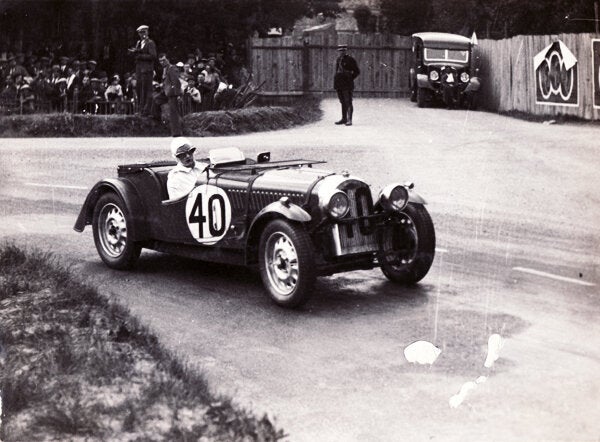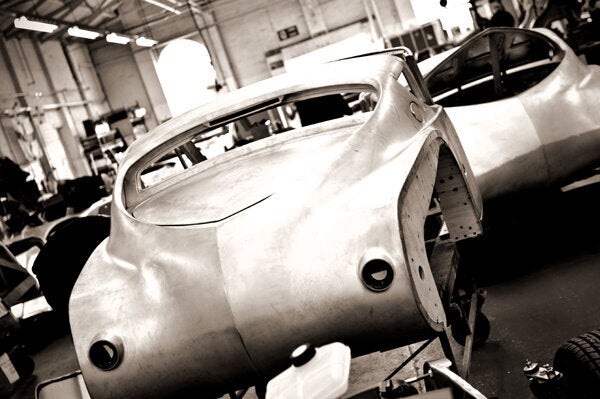Hidden within the small town of Malvern is the Morgan Motor Company. Steeped in tremendous engineering history, the founder, Henry Frederick Stanley Morgan after great encouragement bought a house with a small garage in Worcester road, in May 1905, accommodating Edwardian motorists with repairs. He became a dealer for Darracq, Wolseley, Siddeley and Rover cars. With this garage becoming a great success, he soon had ideas for designing motorcars of his own.
I had the honour of visiting this remarkable family run factory to experience how these cars are made, all crafted by hand, with expert skill, patience and love. Wood is held in brackets with glue to achieve the curved designs, moulds are suction formed, aluminium is hand tapped and crafted. Every workroom has a different function with each person looking after their craft. It is an utter joy to see and by the end of this meticulous production, you will know who has built your car by name.

I knew that some fabulous women raced Morgan cars and as expected, I discovered these notable 'scorchers'. From the start it was very much a family business and Mr H.F.S Morgan's sister, Miss Dorothy Morgan, was a regular entrant in reliability trials gaining many first class awards in a Morgan three-wheeler. In 1913 a Morgan made the fastest time at the celebrated Shelsley Walsh Hill Climb at an average speed of 22 mph. In 1930 Mrs Gwenda Stewart broke the One Hour World Record at the banked race track at Monthléry, south of Paris, at a speed of over 100 m.p.h. She was later to achieve 117 m.p.h. in a single-seater Morgan on the long straight at Arpajon nearby.
Morgans remained at the forefront of competitive motoring and even Harry's daughters were seen at Donington at an A.C.U. rally. In 1938 Miss Prudence Fawcett, a 25 year-old novice driver with little previous competition experience, entered for the Le Mans 24-hour race in a Morgan 4-4 tuned and prepared at the works. Together with co-driver Geoff White, Prudence completed the 24 hours finishing 13th overall and qualifying for the Biennial Cup. Other Morgan drivers continued to race entering the 1996 BPR series (now the FIA GT series) along with Le Mans on various occasions with varying success. For further information about some of the 'Morgan' women please have a look at my new book Girl Racers.
This racing history is as important to the Morgan car as the wheels and the fuel you put inside it. I often think that the craftsmanship of each car made here carries around such a wealth of 'data' from the experiences at the Shelsley Walsh Hill Climbs and Le Mans races, to the development of the new Aero chassis. It really is a car immersed with British history. I thought that a small slice of the family history would help you appreciate how the Morgan car is where it is today: The 'Cyclecar' of Harry's design was at the forefront of this movement for freedom on the roads and Harry Morgan was regarded as the man who introduced motoring for the masses. The prototype was constructed in 1909 and was a simple three-wheeler with a tubular steel chassis fitted with a 7 h.p. Peugeot V-twin engine. One of its main features was the unusual power to weight ratio of 90 brake horsepower per ton, which enabled this little vehicle to accelerate as fast as any car being produced at that time. The factory experimented with other designs such as a four-seater for Mr Morgan and his family, although this car didn't go into production at that time. Not only was the Morgan one of the first Cyclecars, it was well engineered, reliable, and a very successful vehicle in its class which set the standards for all other manufacturers to follow.
The company expanded its factory to nearby Pickersleigh Road with new models added to the Morgan range, and for the first time a four-seater "Family" Runabout was available. Another special Morgan, inspired by Capt. Albert Ball's specially bodied Grand Prix car, was introduced in 1920. This was called the Aero in recognition of the famous aviator. So advanced had H.F.S. Morgan's first designs been, that little alteration, apart from bodywork modifications, were needed for several years. In 1989 the capacity of the Plus Eight was increased from 3.5 to 3.9 litres and this ensured that the Plus Eight continued to be one of the fastest accelerating roads cars. In the mid 1990's, Charles Morgan decided to develop an entirely new chassis. To emphasise the Morgan Motor Company's commitment to environmentally clean, efficient sports cars, in 2008 the remarkable LIFE car was developed in collaboration with QinetiQ and other high-tech organisations. The system includes regenerative braking technology, (capturing up to 50% of kinetic energy during braking and deceleration which would otherwise be lost), using a chassis developed from the Aero, fitted with lightweight aluminium panels assembled around an advanced wooden frame.

In 2009 the Malvern factory celebrated 100 years of the Morgan motorcar with a new visitor centre and gallery. To mark this Centenary, the new Aero Super Sports model was launched and revived the name given to the high performance three-wheeler in the 1930s. In 2011 the Morgan Motor Company also expanded its range and went back to its roots. Two new models were introduced to the Morgan range with the Eva GT.
The factory operates a visiting schedule where you too can look around the factory and discover how the car is physically made, from chassis to frame to engine to body work. A truly heart-warming experience to see before your very own eyes a manufacturing business that is British, over 100 years old and utilises almost the same systems in the 'actualities' as it started with. Craftsmen working to achieve a beautiful motorcar. Please go and have a look. It really is a gorgeous day out and thoroughly educational.
Thank you Charles Morgan for inviting me.
(Photographs courtesy of the Morgan Motor Car archives)